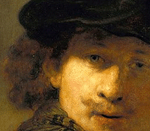
"Peter and John Running to the Tomb"
The full title of this painting is The Disciples Peter and John Running to the Sepulchre on the Morning of the Resurrection. It is Burnand's best-known work. The French state acquired it when it was shown at the Salon de la Société nationale des beaux-arts in 1898.
Mary Magdalene had told Peter and John that Christ's grave was empty and that she did not know where the body had been taken. The disciples then hurry to the grave, their faces expressing deep concern. At the time, they did not know that Christ would rise from the dead.
Eugène Burnand ( 30 August 1850 – 4 February 1921) was a Swiss painter and illustrator.
He was primarily a realist painter of nature. Most of his works were of rural scenes, often with animals, the depiction of which he was a master. He increasingly painted human figures and by the end of his career could be called a portraitist whose skill revealing character was profound.
A deeply religious man, his Protestant beliefs led him to include more religious works that he put his stamp of realism on, and he became best known in Europe for his illustrations of "The Parables", that was published in French, German and English versions over four decades.
Burnand was greatly influenced by artists such as Jean-François Millet and Gustave Courbet. This is reflected in perhaps his best known work, The Disciples Peter and John Running to the Sepulchre on the Morning of the Resurrection 1898, which hangs in the Musée d'Orsay in Paris.